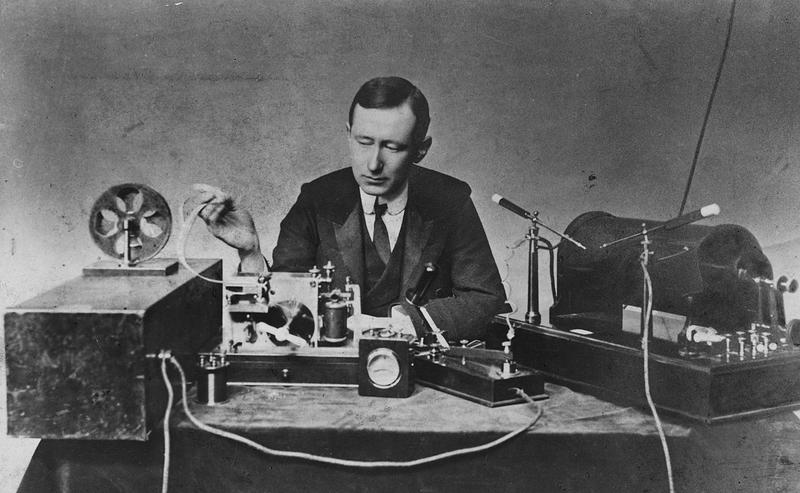Guglielmo Giovanni Maria Marconi, 1st Marquis of Marconi FRSA: Inventor Of Long-Distance Radio
By | April 22, 2021

Guglielmo Giovanni Maria Marconi was born in Bologna, Italy on April 25, 1874 to Italian nobility. He was the great-grandson of Irish distiller John Jameson (yeah, like Jameson Whiskey), and his illustrious upbringing naturally afforded him the best of education, but Marconi was disinterested in school. Instead, he worked solely with private tutors who nurtured his natural curiosity in science. He was primarily fascinated with the nature of electricity and the possibilities it offered. Even with this lenient approach to education, however, he received poor grades and skipped out on college entirely.
When Marconi was in his early twenties, he read the works of Heinrich Hertz (the guy who proved the existence of electromagnetic waves, which is why we measure them in hertz) and became obsessed with the idea of using these waves to send messages across great distances. Sending voices through the air from miles away may have sounded like witchcraft back then, but now we just call it the radio.

Blinding Her With Science
In the beginning, however, sending any kind of message proved very difficult. He used his connections to work with a professor at the University of Bolonga, Augusto Righi, to develop a "wireless telegraphy" machine using an assortment of established apparatus like the coherer transmitter and antenna. He tinkered with the contraption for two years as he lived with his parents, and while his father expressed worry and doubt about his son's seemingly stunted and obsessive behavior, his mother was steadfast in her support, going so far as to bring his dinner to his room so he could eat on his own schedule. Her faith proved justified when, in the dead of night in December 1894, a young Marconi ushered her up to the attic laboratory, where he showed her a button that rang a bell all the way across the room when pressed. No wires, no magic. Just science.
By building taller antennae and grounding them, he quickly proved he could transmit signals from two miles using radio waves (electromagnetic waves between 30-300 gigahertz). In 1896, after getting a shrug from the Italian government that failed to see his work's usefulness, Marconi went to the British government to show proof of concept, successfully transmitting Morse code over a wireless telegraph from over six miles away. With a bit of showmanship, Marconi sent the first overseas telegraph through the Bristol Channel. The received message read, "Are you ready?"

Y'all Ready For This?!
Indeed, the world was. Almost immediately, navies began using the radio to facilitate communication between ships at sea, something never before even imagined. The invention proved useful not only for sending out distress calls but also alerting authorities to ne'er-do-wells who tried to escape jurisdiction, as so many wanted criminals had done before. In 1910, A doctor by the name of Hawley Crippen attempted to outrun English jurisdiction after ruthlessly murdering his wife by slipping onto a ship headed for America but was spotted and, thanks to an onboard wireless telegrapher, apprehended by British authorities before entering international waters.
Although tragic, nothing put Marconi on the map like the sinking of the Titanic, whose 706 survivors owed their lives to the radio operators who sent out the S.O.S. distress call that was received by the nearest ship, the R.M.S. Carpathia, a cold 58 miles away. Freakishly enough, the emergency radio had actually malfunctioned just a few days before, but despite protocol warning against it, the operators Jack Phillips and Harold Bride decided to fix it themselves. Both operators were relieved of duty once the ship was deemed a loss, but Phillips decided to continue sending out distress calls until the power failed and tragically died, along with over 1,000 passengers and crew members. Marconi, who happened to take the infamous ship R.M.S. Lusitania only three days before, boarded Carpathia when it docked in New York City to meet with Bird, one of the few crew members who survived, to thank him for his forethought and bravery.

Everyday Hero
It's impossible to count how many lives have been saved by the invention of radio as it became such a common condition of modern life. Every single mode of transportation has found radio the most reliable and useful communication system, and up until the rise of streaming music, the radio was still the leading medium of entertainment and music. In 1909, both Marconi and Karl Ferdinand Braun (who helped develop the mechanics of the crystal detector) jointly won the Nobel Prize in Physics. To this day, radio technology is used for everyday systems like G.P.S., microwaves, and even smartphones.

